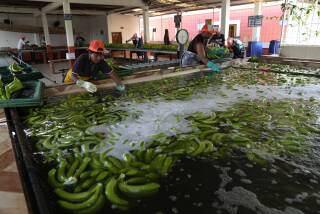U.S. Ready to Admit World Cocaine Supplies Are Vastly Underestimated : Narcotics: Sources say an interagency panel is moving toward accepting CIA analysis increasing annual production figures by at least 250 tons.
WASHINGTON â The federal government, confounded by evidence that record seizures of cocaine have made no dent in the drugâs availability, is preparing to acknowledge it may have vastly underestimated the world cocaine supply, anti-drug officials say.
A long-awaited task force report is expected to estimate that annual cocaine production worldwide could be as much as 700 metric tons--some 250 tons more than the highest previous estimate last year.
The sharp upward revision is being strongly encouraged by the CIA, whose new studies of the cocaine trade have found it to be far more sophisticated than government experts had believed, the officials say.
The official reconsideration was prompted by the stunning discovery last fall of nearly 20 tons of cocaine in a Los Angeles warehouse--an unmatched cache in an unprecedented year of seizures that raised doubts about the accuracy of government statistics.
By previous estimates, last yearâs total seizures of 160 tons would have prevented one-third of the worldâs cocaine supply from reaching market, a significant disruption that should have caused spot shortages and higher prices.
But a confidential new study by the Drug Enforcement Administration has concluded that last yearâs enforcement effort did not produce even a temporary increase in the price of cocaine in any American city, sources say.
âWhen you pick up 20 tons in a single warehouse and nothing happens to the market, you have to ask yourself whether you have an accurate estimate,â one senior Administration official said. âAnd the answer to that question was no.â
The interagency National Narcotics Interdiction Committee, which is due to release its new drug supply report next month, has not yet reached a final decision on the projected size of the world cocaine supply, according to members of the panel.
But well-placed sources said this week that the panel was moving toward agreement on a CIA recommendation that would elevate the estimate of maximum production to about 700 tons a year. (A metric ton equals 2,204.62 pounds.) And on Friday, national drug control policy director William J. Bennett, who ordered the study, told Reuters news service that he âwouldnât be surprisedâ by such a massive increase.
âWhat we said was, âWe want an accurate count, damn it, because nobody gains anything from underestimating the size of the problem,â â Bennett said.
The question of how much cocaine can be produced has major bearing on federal anti-drug efforts, particularly under a new Bush Administration strategy designed to curb the supply of cocaine at its source.
That effort--which received a boost this week when President Bush met in Cartagena, Colombia, with leaders of Colombia, Peru and Bolivia--could require an added influx of U.S. aid if cocaine production in those countries is found to be more extensive than previously believed.
Any change in the cocaine supply figures also would have a major impact on the calculation of how much cocaine enters the United States each year.
While the government refuses to make its estimates public, anti-drug officials operate under the assumption that the United States consumes 80% of the world cocaine supply, meaning that the revised annual U.S. consumption figure could top 550 tons.
The pending report has been preceded by months of internal government debate as officials struggled to make sense of a series of dramatic new glimpses into the cocaine empire.
In the week that followed the 20-ton seizure in Los Angeles last Sept. 29--the largest narcotics haul ever--U.S. authorities found nearly nine tons of cocaine in a home in Harlingen, Tex., and more than five tons on a ship in the Gulf of Mexico.
At the same time, investigators uncovered evidence that the Mexican trafficking organization that accumulated the Los Angeles stash was responsible for other shipments that brought more than 100 tons of cocaine into the United States every year.
And from Colombia, there were new indications that cocaine operations had been more expansive than previously believed.
According to well-placed sources, the issue of how such findings should be interpreted have touched off a battle between a newly assertive CIA, which has been openly skeptical of current estimates, and the Drug Enforcement Administration, the agency responsible for those figures.
The DEA, seeking to determine whether the yearâs major cocaine seizures had any impact on cocaine supply, concluded in its new study that price increases around the country had been brought about only by âentrepreneurialâ dealers, a senior official said.
Nevertheless, David J. LeRoy, the DEAâs strategic intelligence chief, said in an interview that the agency would ask that the current estimates--which put maximum world cocaine production at between 348 and 454 metric tons a year--remain unchanged.
While he conceded that such a move would ânot give the public much confidenceâ in a year that cocaine seizures topped 160 tons, the DEA official stressed there was no evidence to disprove current estimates.
The current figures are based on measurements of the worldâs coca crop and calculations involving the process by which it is transformed into cocaine.
âThis is a very, very unsatisfactory science,â LeRoy said.
But Administration sources said that the efforts of other agencies to move toward a more realistic estimate of cocaine supply appear likely to overcome the DEA opposition within the NNIC committee.
In particular, the sources said, new analyses by the CIA have offered persuasive evidence that cocaine traffickers have found ways to produce the drug far more efficiently than in the past.
A hectare of coca--which previously was believed to result in production of 1.5 kilos of cocaine--might instead produce as much as 2.5 kilos, according to the new calculations. A hectare is the same as 2.5 acres, and a kilogram is 2.2 pounds.
âThereâs been an effort to apply new intelligence to come up with better numbers,â one Administration official said in describing the stepped-up CIA effort. But because of the continuing DEA opposition, he said, âItâs going to be messy.â
More to Read
Sign up for Essential California
The most important California stories and recommendations in your inbox every morning.
You may occasionally receive promotional content from the Los Angeles Times.










